Brilliance of diamond is due to
shape.
cutting
reflection.
total internal reflection.
The correct Answer is:D
Brilliance of a diamond is due to the phenomenon of total internal reflection.
Topper's Solved these Questions
- RAY OPTICS AND OPTICAL INSTRUMENTSBOOK - U-LIKE SERIESCHAPTER - RAY OPTICS AND OPTICAL INSTRUMENTSEXERCISE - FILL IN THE BLANKS
20 Videos
- RAY OPTICS AND OPTICAL INSTRUMENTSBOOK - U-LIKE SERIESCHAPTER - RAY OPTICS AND OPTICAL INSTRUMENTSEXERCISE - TRUE OR FALSE
10 Videos
- RAY OPTICS AND OPTICAL INSTRUMENTSBOOK - U-LIKE SERIESCHAPTER - RAY OPTICS AND OPTICAL INSTRUMENTSEXERCISE - CASE BASED/SOURCE- BASED INTEGRATED QUESTIONS
19 Videos
- NUCLEIBOOK - U-LIKE SERIESCHAPTER - NUCLEIEXERCISE - Self Assessment Test
10 Videos
- SEMICONDUCTOR ELECTRONICS : MATERIALS, DEVICES AND SIMPLE CIRCUITSBOOK - U-LIKE SERIESCHAPTER - SEMICONDUCTOR ELECTRONICS : MATERIALS, DEVICES AND SIMPLE CIRCUITSEXERCISE - SECTION B
1 Videos
Similar Questions
Knowledge Check
Diamond is a
Agood conductor and softBnon-conductor and softCnon-conductor and hardDgood conductor and hardDiamond is a
Ametallic cyrstalBcovalent cyrstalCionic crystalDmolecular cyrstal
Sparking Brilliance of Diamond:
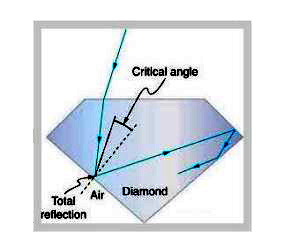
The total internal reflection of the light is used in polishing diamonds to create a sparking brilliance. By polishing the diamond with specific cuts, it is adjusted the most of the light rays approaching the surface are incident with an angle of incidence more than critical angle. Hence, they suffer multiple reflections and ultimately come out of diamond from the top. This gives the diamond a sparking brilliance.
The following diagram shows same diamond cut in two different shapes.
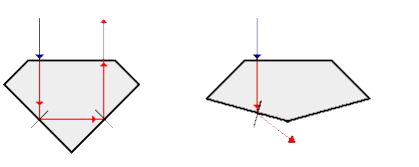
The brilliance of diamond in the second diamond will be:
View SolutionSparking Brilliance of Diamond:
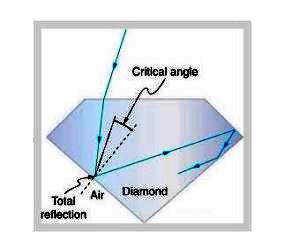
The total internal reflection of the light is used in polishing diamonds to create a sparking brilliance. By polishing the diamond with specific cuts, it is adjusted the most of the light rays approaching the surface are incident with an angle of incidence more than critical angle. Hence, they suffer multiple reflections and ultimately come out of diamond from the top. This gives the diamond a sparking brilliance.
A diamond is immersed in a liquid with a refractive index greater than water. Then the critical angle for total internal reflection will
View SolutionSparking Brilliance of Diamond:
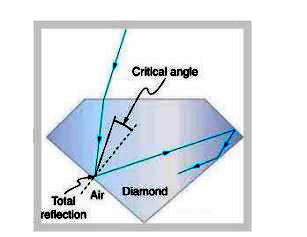
The total internal reflection of the light is used in polishing diamonds to create a sparking brilliance. By polishing the diamond with specific cuts, it is adjusted the most of the light rays approaching the surface are incident with an angle of incidence more than critical angle. Hence, they suffer multiple reflections and ultimately come out of diamond from the top. This gives the diamond a sparking brilliance.
The critical angle for a diamond is 24.4∘. Then its refractive index is
View SolutionSparking Brilliance of Diamond:
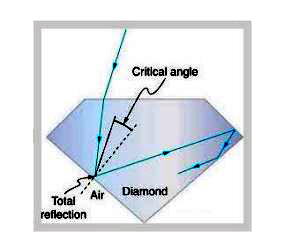
The total internal reflection of the light is used in polishing diamonds to create a sparking brilliance. By polishing the diamond with specific cuts, it is adjusted the most of the light rays approaching the surface are incident with an angle of incidence more than critical angle. Hence, they suffer multiple reflections and ultimately come out of diamond from the top. This gives the diamond a sparking brilliance.
Light cannot easily escape a diamond without multiple internal reflections. This is because:
View SolutionSparking Brilliance of Diamond:
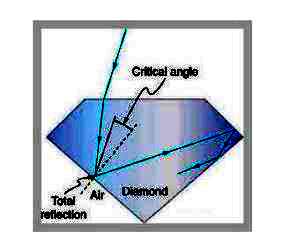
The total internal reflection of the light is used in polishing diamonds to create a sparking brilliance. By polishing the diamond with specific cuts, it is adjusted the most of the light rays approaching the surface are incident with an angle of incidence more than critical angle. Hence, they suffer multiple reflections and ultimately come out of diamond from the top. This gives the diamond a sparking brilliance.
The basic reason for the extraordinary sparkle of suitably cut diamond is that
View SolutionThe sparkling of diamond is due to its very small critical angle. If the refractive index of diamond is 2.4, calculate its critical angle.
View Solution
